- Reducing accidents with enhanced accuracy
Work-related injuries cause businesses billions of dollars cumulatively every year. Most of these injuries happen on the floor of factories. Thus they are called work-related injuries. Sadly, over 70% of these injuries or deaths occur because of unwanted interactions with heavy machinery such as forklifts and other vehicles. With the dangers that these accidents pose to the income and lives of workers, organizations have come up with ways to minimize accidents.
An example is Warny, developed by Bigmate to enhance safety in places of work. It has vehicle collision avoidance, safety zone alert, and thermal analysis to warn people of the pending danger on factory floors. This system uses AWS services that include IoT and machine learning through sophisticated computer vision algorithms to protect people who handle dangerous machines, including forklifts and trucks, and manufacturing equipment.
- Enhancing safety during pandemics
In a pandemic such as the ongoing COVID-19 crisis, returning to the physical workplace has become a challenge that requires strict policies to succeed. Safety approaches such as wearing masks, temperature screening, and social distancing policies have been enforced to reopen offices and ensure the employees remain healthy. In organizations, manual screening of temperature can affect productivity and cause inefficiencies and bottlenecks in entrances and exits. However, with the advanced thermal imaging technology, elevated temperatures can be detected in real-time, and the speed is increased significantly.
Thermy, an AI-based solution, can scan 30 people per second, meaning more than 500 people can be scanned in a minute. This solution uses ML algorithms to check the changes in skin temperature and calculate it accordingly. This is something that manual temperature scanners cannot achieve. Thermy uses computer vision and data from an optical camera to capture the temperature and calculate the representation of skin temperature.
- Mitigating natural disasters
Natural disasters present a significant danger to organizations and employees. As such, solutions for predicting or detecting the disasters before they occur should be sought and used to avert losses and minimize deaths. Companies such as Bigmate have some of these solutions. Bigmate’s solution leverages computer vision and data detection technologies to detect natural disasters such as floods, tsunamis, and infernos by federal and state agencies in real-time. High-tech cameras fixed on aircraft wings are used to capture and collect data such as latitude, time, distance, altitude of disaster landmarks. Other critical information, such as speed, in the case of wind, is also measured.
AI technology is used to calculate information and understand where the incident is, geographically. The real-time data is sent to the meteorological department, where data is merged with population and location data. With this data at hand, safety and environmental organizations that respond to specific disasters look for resources and deploy them accordingly to safe lives and property before the disaster occurs. They can also use such data to prepare for the worsening of the disaster and evacuate the population to safer locations.












